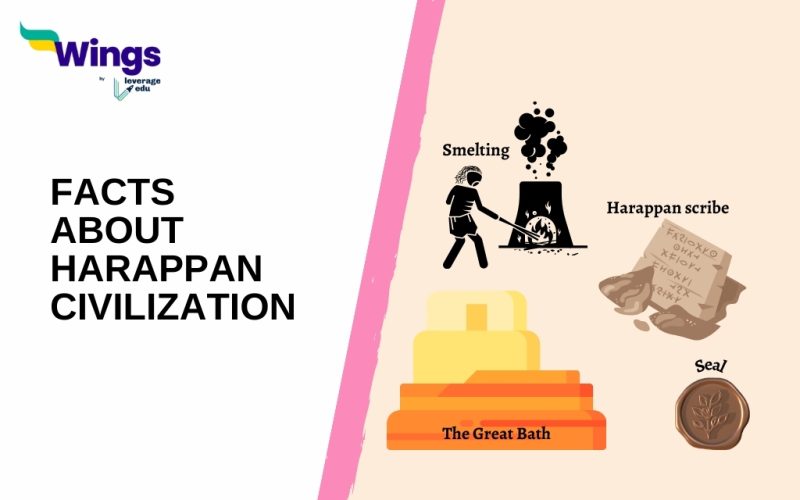Harappan Civilization, also known as the Indus River Valley Civilization, is the earliest known urban culture of the Indian subcontinent. It was first discovered in 1921 in the Harappa region of Punjab followed by the discovery of Mohenjo Daro near the Indus River in the Sindh region. In 1980, UNESCO declared the ruins of Mohenjo Daro World Heritage Site. Here are some interesting facts about the Harappan Civilization.
General Facts About Harappan Civilization
Table of Contents [show]
- Researchers have found evidence of the drilling of human teeth. This shows that Harappan people had a basic knowledge of proto-dentistry.
- In 2001, researchers found eleven drilled molar crowns from a grave located at Mehrgarh.
- The script used during the Harappan civilization has not been deciphered yet.
- Researchers have found artefacts such as toys, games, spinning tops, miniature pots, clay bullock carts, and cubical dice with six holes.
- Art and crafts made during the Harappan Civilization were made using metals like copper, bronze, and terracotta.
- Researchers found 6 granaries in 2 rows featuring advanced technology, later observed in Rome 2800 years later.
- The excavation sites also showcased citadels, burial grounds, and bathing platforms. For example, the Great Bath
- 16 water reservoirs were found at Dholavira, a major Harappan city.
- The bricks used during the Mature Harappan Period measured 7 x 14 x 28 cm and 10 x 20 x 40 cm.
- Harappan Civilization features two and three storey houses.
- It is probably one of the earliest civilizations to have houses with attached bathrooms.
- The city of Mohenjo Daro features an exceptional water management system with 80 public toilets and over 700 wells.
- Buttons during the Indus Valley Civilization were made using seashells.
- It is believed that Mohenjo Daro was built nine times and each time on top of the earlier grid.
Facts About the Size and Location of the Indus Valley Civilization

- Indus Valley Civilization is one of the largest four civilizations in the world. The other three are China, Egypt, and Mesopotamia.
- It was spread over an area of 1,260,000 sq. km.
- It was located in modern-day India and Pakistan and was spread over vast areas such as Western Europe.
- Most of the settlements were located in the region of the Indus and Ghaggar-Hakra Rivers and their tributaries.
- The seven major cities of the Indus Valley Civilization include Mohenjodaro, Kalibangan, Lothal, Chanhudaro, Surkotoda, Dholavira, and Banawali.
- It houses the world’s first few planned cities arranged in grid patterns with streets crossing at right angles.
- The population of the Indus Valley civilization was somewhere about 5 million out of which most were artisans and traders.
Also Read: Decoding the Harappan Civilization (3300-1300 BCE)
Facts About Harappan Seals
- Archaeologists have discovered thousands of seals made using steatite, a special kind of soft stone, gold, terracotta, agate, and ivory.
- The seals found in the Harappan civilization were used for commercial purposes.
- They had pictures of animals, like bison, goats, tigers, and elephants, with something written in a pictographic script.
- The most famous seal of the Harappan Civilization is the Pashupati Seal from Mohenjo Daro. It features a mystical cross-legged figure with animals around.
Facts About Art and Craft of Harrapa Civilization
- Harappan people used ware made of terracotta, copper, and other commonly found metals.
- They were also expert in metal bending and casting.
- Harappans also used the lost-wax casting process.
Facts About the Economy of the Harappa Civilization
- The economy of the Indus Valley or Harappa Civilization was based on agriculture.
- Trade and commerce were also popular during this period.
- Weights and measures found at Lothal were made of steatite and limestone.
- People were engaged in the cultivation of cotton.
- Researchers believe that 16 was the unit of measurement.
Also Read: Bronze Age: Facts, Weapons, Civilisations
Facts About Metallurgy in the Indus Valley Civilization
- Harappans knew the technique of smelting.
- Researchers have found gold necklaces smaller than 0.25 mm in diameter at Lothal.
- They were also well-versed in the method of casting.
Facts About Religion in the Indus Valley Civilization
- Harappans believed in Yoni worship or nature worship.
- They worshipped Fire, called Havan Kund.
- Pashupati Mahadeva was considered the lord of Animals.
- They also worshipped animals.
10 Unique Facts About the Indus River
- The name India is taken from the Indus river
- Indus River headwaters, along with the Yarlung Tsangpo (Brahmaputra), flow along the Indus-Yarlung suture zone.
- The Indus River is known as Sindhu in Sanskrit, Indus in ancient Rome, and ‘Hindu in ancient Persia.
- The river’s flow is not popper. The river has minimum discharge during winter months, rises during the summer, and floods during the monsoon season.
- The Indus River has shifted its course westward, particularly in the Northern Singh over 4500 years ago.
- The upper Indus gets most of its water from the Himalayas, melting snow
- The Indus River is shared by India, Pakistan, China, and Afghanistan. However, Pakistan holds the biggest share.
- The ancient texts like the Rigveda state that the Sindhu River is considered sacred.
- This river is home to the endangered blind Indus River Dolphin.
- The 1960 Indus Waters Treaty helped India and Pakistan to share the water peacefully.
5 Unique Features of the Harappan Civilisation
- The Harappan cities had similar layouts, weights, and bricks, which shows that they had a shared culture or rules.
- Dholavira had an advanced water system with large stone reservoirs.
- The early Harappans at Mehgarh practised dentistry (5500 BCE)
- The Harappans were peaceful and showed few signs of war or big armies.
- They made use of standard weights and measures to organise trade and the economy.
5 Facts About the Harappan Language
- The Harappan language is still undeciphered. Therefore, it cannot be understood
- Their script appears on pots, seals, and small tablets.
- We know more than 600 symbols have been used to communicate. However, we cannot decipher how that was used to communicate
- Harappans were not bilingual. Therefore, it is different from Rosetta Stone
- Scholars guess that the language can be Indo Aryan, Dravidian or a lost family.
FAQs
The river Ganga is considered to be the father of rivers. The Ganges River is sacred in Hinduism. The river is known for its extensive network of tributaries.
Harappans used to eat both plants and animals. They had cultivated a variety of pulses, grains, and oil seeds. Moreover, they used to hunt, and event domesticate animals for meat.
The God of the Harappan civilisation was Pashupati or Proto Shiva. Pashupati was the main deity of the people worshiped by the people. Mohenjo-Daro archaeological excavations had revealed the same.
The Indusl cities are known for their urban planning. These technical and political processes concern make use of land and design of the urban structure. They are also well known for the baked brick houses, a useful drainage system, and a water supply system.
The Indus River was also known as the Sindhu River. Sindhu River is a Sanskrit name for the Indus River. This name is used by the Tibetan and other languages in the region. The word Sindu is the root from which the name India is derived.
Hope you had fun reading these interesting facts about the Harappan Civilization. If you like reading about facts, you can visit our interesting facts page to read more such blogs.
 One app for all your study abroad needs
One app for all your study abroad needs















 45,000+ students trusted us with their dreams. Take the first step today!
45,000+ students trusted us with their dreams. Take the first step today!
